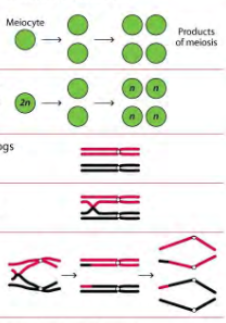FRST 210 lecture 11- sexual reproduction I
1/30
There's no tags or description
Looks like no tags are added yet.
Name | Mastery | Learn | Test | Matching | Spaced |
|---|
No study sessions yet.
31 Terms
Sexual reproduction
Requires fertilization for reproduction
Involves cell division via meiosis
Results in new, genetically different plant
Why is sexual reproduction a strong indication of evolutionary advantage?
It has evolved repeatedly in evolutionary history
How many daughter cells are produced in mitosis? Are homologs paired during cell division? Do chiasmata form between homologous chromosomes? What is the ploidy after cell division? Are the daughter cells genetically identical? (Mother cell with 2N=24 chromosomes)
Two
No
No
24 (2n)
Yes
How many daughter cells are produced in meiosis? Are homologs paired during cell division? Do chiasmata form between homologous chromosomes? What is the ploidy/chromosome count after cell division? Are the daughter cells genetically identical? (Mother cell with 2n=24 chromosomes)
Four
Yes
Yes
12 (n)
no
Homologous chromosomes
Same type of hcromosome
Chiasmata
C(Crossing over points)
Genetic diversity is created in meiosis through this process (genetic recombination) and independent assortment
Major features of meiotic cell division
Chromosomes are replicated and homologous chromosomes (= same type of chromosome) are paired together
Chiasmata forms and portions of DNA are exchanged between homologous pairs
Homologous pairs are separated and assort independently into the daughter cells
Features of sexual reproduction
Sexually reproducing organisms have a haploid (n) phase and a diploid (2n) phase in their life cycles
Ploidy reflects the number of each type of chromosome
Meiosis occurs in diploid cells to create haploid cells
The haploid and diploid phases in organisms can be either unicellular or multicellular → it can be helpful to remember the extent and the nature of haploid and diploid phases
Ploidy
Reflects the number of each type of chromosome
Zygotic meiosis
The haploid phase is unicelluar or multicelluar
Haploid individuals produce haploid gametes (eggs or sperm)
Fertilization create a single-celled zygote (=diploid)
Characteristic of most fungi, some green algae, and many protozoa
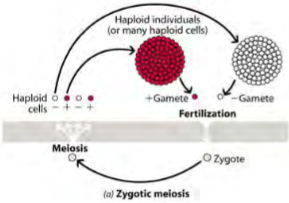
Gametic meiosis
The diploid phase is unicelluar or multicellular
Diploid individuals produce haploid gametes (eggs or sperm)
Fertilization creates a zygote and a new individual (=diploid)
The diploid individual undergoes meiosis to create haploid cells → these develop into gametes, not independent organismss
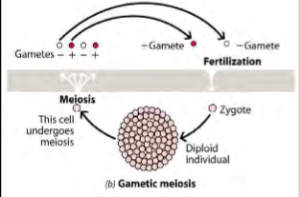
Sporic meiosis
The life cycle involves an alternation of generations
Sporophytes and gametophytes can look similar or toatally different
Gametophytes create gametes via mitosis (not meiosis)
Gametophyte
Haploid, have one set hof chromosomes
Produces the zygote (gamete producing)
Sporophytes
Diploid, have two set of chromosomes
They are the dominant generation, undergo meiosis
Produces spores which gametes arise, dominant form in vascular plants
Contains both gametophyte and megagametophytes
Sporic meiosis
Diploid phase is multicelluar
Diploid individuals (sporophytes) produce haploid spores
Spores germinate to create new multicelluar haploid individuals (gametophytes)
What happens in sporic meiosis?
Life cycle involves an alternation of generations
Sporophyte and gameotophytes can look similar or toally different
Gametophytes create gametes via mitosis (not meiosis)
New sporophute indviduals are created from fertilization via gametes produced by the gametophyte individuals
Alternation of generations
Typical in Kingdom Plantae
Means that the sporophyte (diploid) and gametophyte (haploid) phases (generations) alternate
Sporophyte phase tends to be more complex and dominant compared to the gametophyte phase
Life cycle in ferns (and fer n allies)
Ferns and fern allies (= horsetails, lycophytes, sikemosses, etc.) have gametophytes and sporophytes that are:
Independent
Self-supporting (i.e. photosynthetic)
Homosporous
Sporophytes are the domminant generation in ferns (and fern allies) and produce sporangia
Develop on specialized leves called sporophylls
Site of meiosis → produces haploid sppores
Homospory
Producing a single type of spore that develops into a bisexual gametophyte
What is the term when sporangia are clustered together?
Sorus, plural name is sori)
Are most ferns homosporous or heterosorous?
They are homosporous, as a single type of spore is released and germinates to reate an independent gametophyte
What does the bisexual gametophyte created from homospory develop?
Archegonia (egg-producing)
Antheridia (serm-producing)
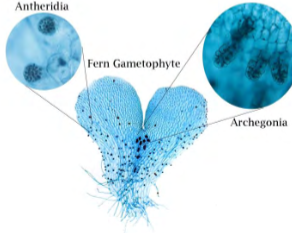
What does fertilization of egg and sperm create in fens?
Fertilizzation creates a new diploid sporophyte that develops on the gametophyte
The gametohyte does not survive this process and is crushed by the new sporophyte
Differences of homospory and heterospory
Most ferns and fern allies are homosporous (sporangia undergo meiosis to create one type of spore)
Some species of ferns and clubmosses evolved two types of spores, so only some of these species are heterosporous, and each type of spore creates a different gametophyte.
Heterospory is considered evolutionarily advantangeous as it has evolved repeatedly in lants.
Four steps of fern life cycle
Spore dispersal
Mature gametophyte develops, and sperm and egg come together and fertilize
New sporophyte grows on the gametohyte
Mature sporophyte develops and creates sporangium, and releases spores again.
What do megasporangium create?
Megasporangium produces megaspores
Megasporangia→ megaspore→megagametophyte (egg producing)
What do microsporangium create?
Microsporangium produces microspores
Microsporangium→microspore→microgametophyte (sperm producing)
What do microgametophytes develop to encase sperM?
Antheridia
What do megagametophytes develop to encase eggs?
Archegonia
Mitosis in somatic cells
One cell division, resulting in two daughter cells
Chromosome number per nucleus maintained (e.g., for a diploid cell)
Interphase (Duplicates chromosomes, not apart of mitosis)
Prophase (Chromosomes are visible condensing
Metaphase (Chromatids are lined up at the middle of the cell)
Anaphase (Chromatids are pulled away by spindles, moved to opposite sides of the cells)
Telophase (New nuceli are forming to make two new cells)
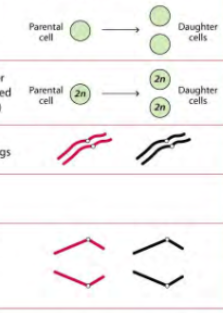
Meiosis in cells in the sexual cycle
General notes:
Two cell divisions, resulting in four products of meiosis
Chromosome number halved in the products of meiosis
Full synapsis of homologs at prophase I
At least one chiasma
Promotes variation among the products of meiosis
Cell undergoing meiosis is diploid
Cell becomes an haploid cell
Processes:
Prophase I(Chromosomes are visible condensing and match up with their homologous pairs (around the same size, and contain the same types of genes in the same locations, and chromosomes cross over, resulting in recombinant chromosomes)
Metaphase I (Chromosomes are in the middle, but are in the middle
Anaphase I (Chromosomes in pairs are pulled away
Telophase I (New nuclei are forming to make two new cells, and undergo cytokinesis to make new cells)
Part 2 (Same :
Prophase II (Chromosomes condense in both cells, and the nuclear envelope is broken)
Metaphase II (The chromosomes are in the middle of the cell, and the chromosomes are in a single line)
Anaphase II (The chromatids are pulled away from each other)
Telophase II (The chromosomes are split by cytokinesis to create four non-identical cells)
